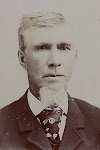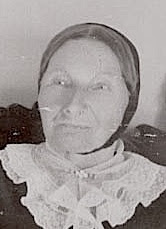How did the Eau Galle River get its name?
[Updated 9/22/2008]
While researching family history I recently came across two intriguing letters published years ago in the
Wisconsin Magazine of History. They each independently discuss the origin and meaning of the name for the Eau Galle River. And a third reference of the name's meaning was also found from a report by U.S. Army Corp of Engineers. The Eau Galle and its wooded hills are so much a part of the local landscape in Spring Valley and because the river's name is unique, I found these letters fascinating.
The first letter was written by Robert K Boyd of Eau Claire and was published in March of 1920. In part of his letter, Mr. Boyd discerns the meaning of river’s name based on a copy of a very old lumber contract he obtained. It is dated June 10, 1844. This document called for a “season’s cut of lumber” to be milled at the Carson & Eaton Mill which was located at the present day village of Eau Galle. The spelling of river’s name in this document is not Eau Galle but rather “Augallett” and Augalett.” These spellings, Mr. Boyd says, are clues to the intended words of: “Au Galet.” In French this can mean “in the pebbles.”
A completely independent letter was published regarding the Eau Galle by the same magazine but a different author and some twelve years forward. Camille Bisson’s wrote in December of 1932 to tell her understanding of the river’s name. Her story further illuminates what Mr. Boyd wrote. She describes a childhood period that occurred some 65 years prior, during the early 1860s. This is when a traveling French-Canadian trapper stayed with her family for a few days.
During his stay, the itinerate trapper regaled her family with stories of place names, translated from an Indian language to French, that were given to the various features of the land. The trapper was literate in both French and English and well educated. Now it happened that Camille’s parents were recent immigrants from France, and her mother was teaching her French during the trapper’s stay. So the trapper took some time to teach the young Camille several French river and lake names in Wisconsin, including “Rivière aux Galets,” “Rivière aux Clercs,” “Sault Saint Croix,” and “Lac du Flambeau.”
Camille goes on to write that their guest explained “Rivière aux Galets” is known to us as the “Eau Galle River.” “Rivière” in French means “river”; “aux” means “of the” or “in the” and “Galets” means “stones” (or more accurately, “small round pebbles.”) So a literal translation becomes “River in the Pebbles.” “Rivière aux Galets” is pronounced “RIV-YAIR O GAL-LAY.” Try saying these words out-loud, with a French accent, and you will see how “Galet” became anglicized to “Galle.”
Camille lived in Downsville at the time she wrote the letter. She must have been familiar with the river valley north of Spring Valley as she points out that the Eau Galles’ “upper reaches are very stony,” and indicates that this may be the reason for the river’s name. Some readers will know that the stretch of the Eau Galle upstream of Lake George serpentines north several miles cutting into the limestone hills. My father, Vic Ducklow, always referred to this area as “Rocky Coulee.” After a large spring runoff, the floor of Rocky Coulee is littered with a fresh bed of uncountable numbers of rocks, stones, and pebbles as well as other flotsam scoured out by a strong current. It seems that this part of the river could have been the inspiration for its name.
In Robert Boyd’s letter of 1920 he points to the mouth of the Eau Galle that empties into the Chippewa River as the reason for its name. Here the river has deposited is a “heavy gravel bar.” He states that it seems natural that the early explorers gave the river a literal name “The River in the Pebbles” based on this feature. Others that Mr. Boyd conferred with agreed that the river was named for its identifiable gravel mouth were it meets the Chippewa River.
Unfortunately, Camille Bisson does not say in her 1932 letter how old she thought the French-Canadian trapper was. But assuming he was at least age 40, his childhood and early adulthood would have occurred during the 1820s and 1830s⎯a period when just a handful of European men journeyed in the area to hunt, fish, and trap. Generally speaking, these men comfortably shared the land with the native peoples and often learned their languages—including their place names.
When mapmakers of the 1800s wanted to identify the names of land features, they called upon the early voyagers, hunters, trappers, and fur traders for their understanding of the proper names. In many cases these men were French or French-Canadians. In this way the Indian names became translated French names. And over time, the French names were modified again to be more pronounceable to the growing demand for maps in English. As Camille Bisson writes, the names became “corrupted.” The French “Rivière aux Galets” was simplified to “Eau Galle.” The pronunciation of “aux” and “eau” are very similar; both are spoken as “O.” Coincidently, “eau” means water. This no doubt caused confusion for the non-French speaking immigrants and so two words “Rivière aux” became understood as “Eau.”
Once on a map, identifying place names became generally accepted and used by a rising tide of permanent settlers to the territory. And settlers started coming in larger numbers during the later half of the 1800s for lumber, land, and then (at least in Spring Valley) iron ore!
While Robert Boyd’s letter of 1920 or Camille Bisson’s letter of 1932 are not definitive proof of how the Eau Galle was named, they certainly have an elegance that fits our area’s history and offer a sense of authority that is hard to not accept. If you would like to read the original letters, these links will take you to a PDF view at the Wisconsin History Society:
1920 Boyd Letter 1932 Bisson Letter1981 U.S. Corp of Engineers Cultural Resources ReportIn addition to the letters of Boyd and Bisson, another terse reference to French meaning of the Eau Galle appears in a report published for the U.S. Army Corp of Engineers. Apparently the Army Corp, who manages the Eau Galle Reservoir, hired a company to research cultural aspects of the area. The report created and published by Archaeological Field Services, Inc. in 1981. Parts of the report were republished in local history book called "... And All Our Yesterdays" published in 1988 by the Spring Valley Area Chapter of the Pierce County Historical Association.
With all that said, the one sentence quote from the report that is of interest is: "The L'Eau Galle, from the French meaning 'River of the Gravel Bank.'" Sadly, no sources for this intreputation are supplied (at least in the excerpt that was republished). However, it is consisant with both the Boyd and Bisson letters.
--
So there you have it. You might now properly call the Eau Galle River the “River in the Pebbles” next time you see it.



























